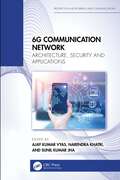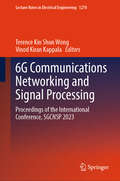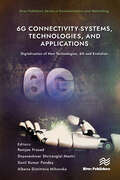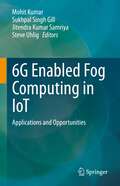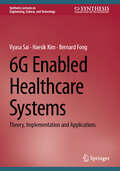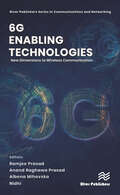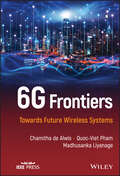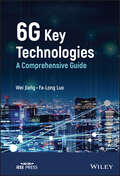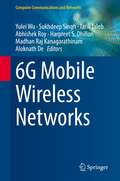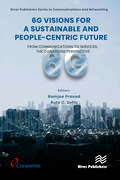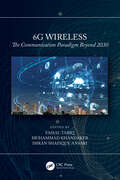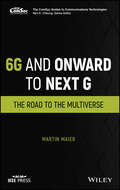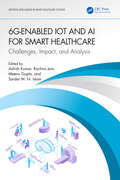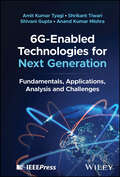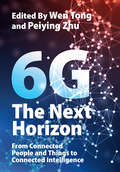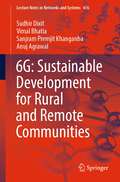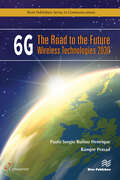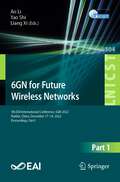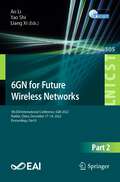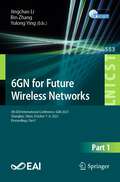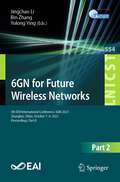- Table View
- List View
60GHz Technology for Gbps WLAN and WPAN
by Pengfei Xia Su-Khiong Yong Alberto Valdes-GarciaThis book addresses 60 GHz technology for Gbps WLAN and WPAN from theory to practice, covering key aspects for successful deployment.In this book, the authors focus specifically on 60 GHz wireless technology which has emerged as the most promising candidate for multi-gigabit wireless indoor communication systems. 60 GHz technology offers various advantages over current or existing communications systems (e.g. huge unlicensed bandwidth worldwide, high transmit power, high frequency reuse and small form factor), which enables many disruptive applications that are otherwise difficult if not impossible to be realized at lower frequencies. The book addresses all aspects of the state-of-the-art in 60 GHz technology for high data rate wireless applications.Key Features:Comprehensive coverage from theory to practice: provides readers with a thorough technical guide of 60 GHz technology development Brings together the entire area of 60GHz technology for Gigabits per second (Gbps) WLAN and WPAN applications. Discusses practical system designs covering wide aspects such as antenna propagation, beamforming, circuit design, digital communication, signal processing, system architectures, etc. Provides up-to-date standardization activities, regulatory issues, technology development as well as future trends Includes examples and case studies for practical scenarios Contains theoretical, simulation and experimental results to demonstrate and compare the performance of various schemes (or systems) This book serves as an excellent reference for system engineers, system architects, IC designers, standard engineers, researchers, and vendor and manufacturer consumers. Technical consultants, software and application developers will also find this book of interest.
64 Geeks: The Brains Who Shaped Our World
by Chas Newkey-BurdenWe wouldn't have Bluetooth or Wi-Fi today without the ingenuity of an actress once described as "the most beautiful woman in the world."And we might have had mobile messaging as early as 1901, were it not for the fickleness of a banker. From celebrated prodigies and self-proclaimed geniuses to history's hidden heroes-64 GEEKS brings you the incredible stories of the world's best brains, all presented alongside clever 8-bit likenesses.
64 Geeks: The Brains Who Shaped Our World
by Chas Newkey-BurdenWe wouldn't have Bluetooth or Wi-Fi today without the ingenuity of an actress once described as "the most beautiful woman in the world."And we might have had mobile messaging as early as 1901, were it not for the fickleness of a banker. From celebrated prodigies and self-proclaimed geniuses to history's hidden heroes-64 GEEKS brings you the incredible stories of the world's best brains, all presented alongside clever 8-bit likenesses.
6G Communication Network: Architecture, Security and Applications (Prospects in Networking and Communications – P-NetCom)
by Ajay Kumar Vyas Narendra Khatri Sunil Kumar JhaThis book focuses on 6G technology beyond 5G. The objective of next generation 6G wireless communications is to improve the benchmarks while simultaneously delivering additional services. Many widely expected future services, such as life‑critical services and wireless brain‑computer interactions, will be important to their success. This book presents the evolution of 6G technology, architecture, and implementation. This book provides a comprehensive overview of the theoretical and experimental modelling of 6G communication, providing detailed implementation issues and performance evaluation of emerging technologies along with research results, and networking methods.This book:• Contains a comprehensive overview of 6G communication network technology.• Contains both fundamental theories and cutting‑edge technologies.• Covers implementations, architecture, security, privacy, and reliability in 6G communication and performance analysis of the 6G communication.• Future trends and applications covered include vehicle‑to‑everything, massive radio access networks, Massive IoT Access Cybertwin, Sustainable Society 5.0 using 6G communication.• Covers the challenges and research directions to enable future research to make 6G communication a wireless solution for sustainability.• Contains a comprehensive overview of 6G communication network technology.• Contains both fundamental theories and cutting‑edge technologies.• Covers implementations, architecture, security, privacy, and reliability in 6G communication and performance analysis of the 6G communication.• Future trends and applications covered include vehicle‑to‑everything, massive radio access networks, Massive IoT Access Cybertwin, Sustainable Society 5.0 using 6G communication.• Covers the challenges and research directions to enable future research to make 6G communication a wireless solution for sustainability.This book is primarily written for senior undergraduate students, graduate students, and academic researchers in the fields of electrical engineering, electronics, communications engineering, and computer science and engineering.
6G Communications Networking and Signal Processing: Proceedings of the International Conference, SGCNSP 2023 (Lecture Notes in Electrical Engineering #1270)
by Terence Kin Shun Wong Vinod Kiran KappalaThis book includes peer-reviewed papers of the International Conference on 6G Communications Networking and Signal Processing-SGCNSP 2023. This book focuses on conceptual frameworks that help understand the basics of electronics, electrical, and communication. It also provides an overview of the upcoming advanced technologies supporting 6G signal processing, communication systems and networks, mobile and wireless networks, and RF and optical communication. This book is useful for undergraduate and postgraduate students and research scholars.
6G Connectivity-Systems, Technologies, and Applications: Digitalization of New Technologies, 6G and Evolutio (River Publishers Series in Communications and Networking)
by Ramjee Prasad Sunil Kumar Pandey Dnyaneshwar Shriranglal Mantri Albena Dimitrova MihovskaThis book covers need for 6G connectivity arising from the pursuit of higher data speeds, ultra-low latency, massive IoT connectivity, enhanced spectral efficiency, and the facilitation of new and transformative applications. By addressing these drivers and expectations, 6G aims to revolutionize wireless communication, opening up a realm of possibilities for industries, societies, and individuals.Technological improvements and evolutions are required beyond fifth-generation (5G) networks for wireless communications as well as in the industry where the involvement of collaborative robots (COBOT) will satisfy the personal needs of human beings as and when required leading to human–machine interactions. A considerable amount of effort has been devoted, both in industry and academia, towards the performance modelling, evaluation and prediction of convergent multi-service heterogeneous, future-generation networks such as 6G.Technical topics discussed in the book include: Network security and attacks 6G applications and Industry 5.0 Human centric interface Green computing in wireless cellular networks Next generation networks (IOT, Cloud Computing, Big Data, etc.)
6G Enabled Fog Computing in IoT: Applications and Opportunities
by Steve Uhlig Mohit Kumar Sukhpal Singh Gill Jitendra Kumar SamriyaOver the past few years, the demand for data traffic has experienced explosive growth thanks to the increasing need to stay online. New applications of communications, such as wearable devices, autonomous systems, drones, and the Internet of Things (IoT), continue to emerge and generate even more data traffic with vastly different performance requirements. With the COVID-19 pandemic, the need to stay online has become even more crucial, as most of the fields, would they be industrial, educational, economic, or service-oriented, had to go online as best as they can. As the data traffic is expected to continuously strain the capacity of future communication networks, these networks need to evolve consistently in order to keep up with the growth of data traffic. Thus, more intelligent processing, operation, and optimization will be needed for tomorrow’s communication networks. The Sixth Generation (6G) technology is latest approach for mobile systems or edge devices in terms of reduce traffic congestions, energy consumption blending with IoT devices applications. The 6G network works beyond the 5G (B5G), where we can use various platforms as an application e.g. fog computing enabled IoT networks, Intelligent techniques for SDN network, 6G enabled healthcare industry, energy aware location management. Still this technology must resolve few challenges like security, IoT enabled trust network.This book will focus on the use of AI/ML-based techniques to solve issues related to 6G enabled networks, their layers, as well as their applications. It will be a collection of original contributions regarding state-of-the-art AI/ML-based solutions for signal detection, channel modeling, resource optimization, routing protocol design, transport layer optimization, user/application behavior prediction 6G enabled software-defined networking, congestion control, communication network optimization, security, and anomaly detection. The proposed edited book emphasis on the 6G network blended with Fog-IoT networks to introduce its applications and future perspectives that helps the researcher to apply this technique in their domain and it may also helpful to resolve the challenges and future opportunities with 6G networks.
6G Enabled Healthcare Systems: Theory, Implementation and Applications (Synthesis Lectures on Engineering, Science, and Technology)
by Bernard Fong Haesik Kim Vyasa SaiThis book introduces 6G enabled healthcare systems and helps readers understand state-of-the-art techniques and applications for future healthcare systems. Readers will be able to obtain a background knowledge about AI, wireless systems, implementation methods, and applications, enabling the upcoming migration from 5G to 6G for supporting mission-critical healthcare applications.
6G Enabling Technologies: New Dimensions to Wireless Communication (River Publishers Series in Communications and Networking)
by Ramjee Prasad Albena Mihovska Anand Raghawa PrasadThe sixth generation of wireless communication (6G), succeeding 5G cellular technology, opens up several possibilities in terms of technology and its offered services. 6G is expected to allow usage of available higher frequency spectrums to cater to increased capacity, throughput, and low latency ( To make this book a fundamental resource, we have invited world-renowned experts in 6G from the industry and academia to pen down their ideas on different aspects of 6G research. The chapters in this book cover a broader scope and various related and unrelated verticals. Specifically, this book covers the following topics: 6G use cases, requirements, and enabling technologies new spectrums and their challenges for 6G privacy preservation in 6G networks aerial infrastructure for 6G networks economic challenges associated with 6G wireless networks. The encompassing intent of this book is to explore the evolution from current 5G networks towards the future 6G networks from a service, air interface, and network perspective, thereby laying out a vision for 6G networks.
6G Frontiers: Towards Future Wireless Systems
by Madhusanka Liyanage Chamitha de Alwis Quoc-Viet Pham6G Frontiers Enables readers to understand the exciting new technologies, architectural directions, technical aspects, and applications of 6G, plus legal and standardization approaches 6G Frontiers offers intelligent insight into the ongoing research trends, use cases, and key developmental technologies powering the upcoming 6G framework. The authors cover a myriad of important topics that intersect with 6G, such as hyper-intelligent networking, security, privacy, and trust, harmonized mobile networks, legal views, and standards initiatives. The work also explores the more extreme and controversial predictions surrounding 6G, such as hyper-connected smart cities, space tourism, and deep-sea tourism. Sample thought-provoking topics covered in the comprehensive work include: Evolution of mobile networks, from 0G to 6G, including the driving trends, requirements, and key enabling technologies of each generation Logistics of 6G networks, which are expected to offer peak data rates over 1 Tbps, imperceptible end-to-end delays (beneath 0.1 ms), and network availability and reliability rates beyond 99.99999% New technology requirements for 6G, such as Further enhanced Mobile Broadband (FeMBB), ultra-massive Machine-Type Communication (umMTC), Mobile BroadBand and Low-Latency (MBBLL), and massive Low-Latency Machine Type communication (mLLMT) Potential architectural directions of 6G, including zero-touch network and service management, intent-based networking, edge AI, intelligent network softwarization, and radio access networks A complete and modern resource for understanding the potential development, logistics, and implications of 6G networks, 6G Frontiers is a must-read reference for researchers, academics, and technology architects who wish to understand the cutting-edge progress that is being made towards better and faster wireless mobile technology.
6G Key Technologies: A Comprehensive Guide (IEEE Press)
by Fa-Long Luo Wei Jiang6G Key Technologies An accessible and integrated roadmap to the technologies enabling 6G development In 6G Key Technologies: A Comprehensive Guide, two internationally well-recognized experts deliver a thoroughly original and comprehensive exploration of the technologies enabling and contributing to the development of 6G. The book presents the vision of 6G by reviewing the evolution of communications technologies toward 6G and examining the factors driving that development, as well as their requirements, use cases, key performance indicators, and more. Readers will discover: Thorough introductions to the standardization and technology evolution toward 6G, as well as the vision behind the development of 6G in terms of architectures, algorithms, protocols, and applications. In-depth explorations of full-spectrum wireless technologies in 6G, including enhanced millimeter wave technologies, terahertz-based communications and networking, visible-light and optical wireless communications. Fulsome discussions of smart radio networks and new air interface technologies for 6G including intelligent reflecting surface, cellular massive MIMO, cell-free massive MIMO, adaptive and non-orthogonal multiple access technologies. Perfect for professional engineers, researchers, manufacturers, network operators, and software developers, 6G Key Technologies: A Comprehensive Guide will also earn a place in the libraries of graduate students studying in wireless communications, artificial intelligence, signal processing, microwave technology, information theory, antenna and propagation, system-on-chip implementation, and computer networks.
6G Mobile Wireless Networks (Computer Communications and Networks)
by Yulei Wu Abhishek Roy Sukhdeep Singh Tarik Taleb Harpreet S. Dhillon Madhan Raj Kanagarathinam Aloknath DeThis book is the world’s first book on 6G Mobile Wireless Networks that aims to provide a comprehensive understanding of key drivers, use cases, research requirements, challenges and open issues that are expected to drive 6G research. In this book, we have invited world-renowned experts from industry and academia to share their thoughts on different aspects of 6G research. Specifically, this book covers the following topics: 6G Use Cases, Requirements, Metrics and Enabling Technologies, PHY Technologies for 6G Wireless, Reconfigurable Intelligent Surface for 6G Wireless Networks, Millimeter-wave and Terahertz Spectrum for 6G Wireless, Challenges in Transport Layer for Tbit/s Communications, High-capacity Backhaul Connectivity for 6G Wireless, Cloud Native Approach for 6G Wireless Networks, Machine Type Communications in 6G, Edge Intelligence and Pervasive AI in 6G, Blockchain: Foundations and Role in 6G, Role of Open-source Platforms in 6G, and Quantum Computing and 6G Wireless. The overarching aim of this book is to explore the evolution from current 5G networks towards the future 6G networks from a service, air interface and network perspective, thereby laying out a vision for 6G networks. This book not only discusses the potential 6G use cases, requirements, metrics and enabling technologies, but also discusses the emerging technologies and topics such as 6G PHY technologies, reconfigurable intelligent surface, millimeter-wave and THz communications, visible light communications, transport layer for Tbit/s communications, high-capacity backhaul connectivity, cloud native approach, machine-type communications, edge intelligence and pervasive AI, network security and blockchain, and the role of open-source platform in 6G. This book provides a systematic treatment of the state-of-the-art in these emerging topics and their role in supporting a wide variety of verticals in the future. As such, it provides a comprehensive overview of the expected applications of 6G with a detailed discussion of their requirements and possible enabling technologies. This book also outlines the possible challenges and research directions to facilitate the future research and development of 6G mobile wireless networks.
6G Visions for a Sustainable and People-centric Future: From Communications to Services, the CONASENSE Perspective (River Publishers Series in Communications and Networking)
by Ramjee Prasad Rute C. Sofia6G is currently under definition, being often addressed from a plain telecommunications perspective as an evolutionary paradigm that represents an extension of 5G. Having as a horizon 2030, 6G initiatives are being deployed across the globe to further ignite the development of 6G services. At its philosophical core, 6G embodies the "human in the loop" principle. The research effort being developed towards 6G requires an interdisciplinary approach that ignites discussion across different key technological sectors, ranging from communications up to services and business cases. The contributions of this book to research in the field concern an evolutionary and interdisciplinary design of 6G as a paradigm that can be addressed by working together four different computational areas: communications; satellites and navigation; sensing; services. The book is derived from initial brainstorming that was developed during the 11th CONASENSE Symposium held in October 2021 in fortiss, Munich, Germany. Several international experts contribute to an overview of 6G key challenges, new networking trends and challenges to be overcome, and advanced 6G services. The book starts with a perspective on 6G challenges and use-cases beyond the 2030 horizon, to then continue to address the role of non-terrestrial networks and cognitive, service-centric satellite networks in future 6G services. Still with focus on 6G adaptive networking, the book continues with a debate on the need to integrate social awareness based on an interdisciplinary approach in network operations. Then, specific examples of advanced services (quantum imaging and holography; localization of the Internet of remote things) are discussed. The book is, therefore, intended to assist in developing critical thinking to back up novel networking, applications, and services towards 6G.
6G Wireless: The Communication Paradigm Beyond 2030
by Faisal Tariq Muhammad Khandaker Imran Shafique Ansari6G Wireless: The Communication Paradigm Beyond 2030 offers a thorough discussion of some key emerging technologies such as Intelligent Reflecting Surface (IRS), Unmanned Aerial Vehicles (UAV), Aerial Computing, Terahertz (THz) Communications, Non-Orthogonal Multiple Access (NOMA) and Rate Splitting Multiple Access (RSMA).The book provides a comprehensive coverage of the vision, requirements, use cases, enabling technologies, and challenges for the future 6G wireless communication systems. This includes discussions on how 6G and future IoT systems will enable extremely low latency healthcare systems, smart industry, haptic communications, programmable wireless environment (PWE), advanced VR/AR and holographic communications. IRS is expected to play a prominent role in 6G and the book thoroughly discusses the role of IRS in enabling physical layer security, UAV communications as well as D2D communications. It also explains channel modeling for IRS enabled PWE.Another key aspect of the book is that it provides a comprehensive discussion on security challenges of emerging 6G systems and their potential solutions. Apart from this, it also explains how blockchain techniques can be used for future IoT applications such as intelligent manufacturing and asset tracking.Written in tutorial style, the book is primarily intended for postgraduate students and researchers in the broad domain of wireless communications as well as research-active academics. The book can also be useful as a reference book for BSc/MSc project/thesis works.
6G and Onward to Next G: The Road to the Multiverse (The ComSoc Guides to Communications Technologies)
by Martin MaierThis book weaves emerging themes in future 6G and Next G networks carefully together. It points to three spheres of contexts with different narratives for the year 2030 and beyond, in which the coming Metaverse as the precursor of the future Multiverse can be embedded naturally. The book aims at providing the reader with new cross-disciplinary research material, ranging from communication and computer science to cognitive science, social sciences, and behavioral economics, for building a deeper Metaverse. It will be instrumental in helping the reader find and overcome some of the most common 6G and Next G blind spots. Modern networks are more than communication and computer science. They may be better viewed as techno-social systems that exhibit complex adaptive system behavior and resemble biological superorganisms. 6G and especially Next G should go beyond continuing the linear incremental 6G=5G+1G mindset of past generations of mobile networks. To this end, the book: Helps readers inquire into new areas of knowledge or understanding that they didn’t have or didn’t pay attention to find their 6G/Next G blind spots Highlights the unique potential benefits of the virtual world for society in that it provides a useful extension of the real-world economy by compensating for its well-known market failures, e.g., rising income inequality Provides a comprehensive description of the original Metaverse vision and highlights the different Metaverse components, applications, open research challenges, and early Metaverse deployment examples from both industry and academia Describes how the Multiverse goes beyond the Metaverse origins and explores the importance of experience innovation since experiences play a central role in the Metaverse Explains Web3 and the emerging field of token engineering and tokenization, i.e., the process of creating tokenized digital twins via programmable tokens, which are viewed as the killer application of Web3 networks for creating technology-enabled social organisms and restoring tech-driven common goods Reviews anticipated 6G paradigm shifts and elaborates on the difference between 6G and Next G research, including Next G Alliance’s audacious goals and their symbiotic relationship between technology and a population’s societal and economic needs Doubles down on the mutually beneficial symbiosis between digitalization and biologization for our possible evolution into future metahumans with infinite capabilities by making us smarter and creating a fundamentally new form of sociality in the Metaverse and Multiverse as well as the future stigmergy enhanced Society 5.0 by leveraging on time-tested self-organization mechanisms borrowed from nature Presents a variety of different concepts of the true nature of reality that bring us closer to the original Metaverse vision and explains how 6G, Next G, and the Metaverse may eventually pave the way to the peak-experience machine that democratizes access to the upper range of human experiences Touches on the possible transition from communication to services beyond communication, most notably the cross-cultural phenomenon of communitas in anthropology and its increasing degrees of perceived connectedness with others, the world, and oneself, given the importance of creating a deep sense of community in the Metaverse Written for students, network researchers, professionals, engineers, and practitioners, 6G and Onward to Next G: The Road to the Multiverse explores the latest Internet developments, with a particular focus on 6G and Next G networks in the context of the emerging Metaverse and future Multiverse as the successors of today’s mobile Internet that has defined the last two decades.
6G-Enabled IoT and AI for Smart Healthcare: Challenges, Impact, and Analysis (Artificial Intelligence in Smart Healthcare Systems)
by Ashish Kumar Meenu Gupta Rachna Jain Islam, Sardar M.N.In today’s era, there is a need for a system that can automate the process of treatment for the patient if medical facilities are out of reach. Smart healthcare can step in to make the patient more self-dependent. 6G with its features can be seen as the future of smart healthcare with IoT and AI. 6G-Enabled IoT and AI for Smart Healthcare: Challenges, Impact, and Analysis offers the fundamentals, history, reality, and challenges faced in the smart healthcare industry today. It discusses the concepts, tools, and techniques of smart healthcare as well as the analysis used. The book details the role that machine learning-based deep learning and 6G-enabled IoT concepts play in the automation of smart healthcare systems. The book goes on to presents applications of smart healthcare through various real-world examples and includes chapters on security and privacy in the 6G-enabled and IoT environment, as well as research on the future prospects of the smart healthcare industry. This book: Offers the fundamentals, history, reality, and the challenges faced in the smart healthcare industry Discusses the concepts, tools, and techniques of smart healthcare as well as the analysis used Details the role that machine learning-based deep learning and 6G-enabled IoT concepts play in the automation of smart healthcare systems Presents applications of smart healthcare through various real-world examples Includes topics on security and privacy in 6G-enabled IoT, as well as research and future prospectus of the smart healthcare industry Interested readers of this book will include anyone working in or involved in smart healthcare research which includes, but is not limited to healthcare specialists, computer science engineers, electronics engineers, systems engineers, and pharmaceutical practitioners.
6G-Enabled Technologies for Next Generation: Fundamentals, Applications, Analysis and Challenges
by Shivani Gupta Amit Kumar Tyagi Shrikant Tiwari Anand Kumar MishraA comprehensive reference on 6G wireless technologies, covering applications, hardware, security and privacy concerns, existing challenges, analytics methods, and much more 6G-Enabled Technologies for Next Generation delivers a thorough overview of the emerging sixth generation of wireless technology, presenting critical challenges of implementing 6G technologies including spectrum allocation, energy efficiency, security, interoperability, and more. Explaining ways we can use technologies to ensure a sustainable environment through renewable energy and a resilient industry, this book covers the applications and use cases such as smart grid, IoT, smart manufacturing, addressing security and privacy issues with privacy-preserving techniques and authentication control mechanisms. This book discusses the analytical methods used to study the performance of 6G technologies, covering simulation techniques, performance metrics, and predictive modeling. Introducing the core principles of 6G technology, including the advantages and disadvantages of the technology and how wireless communications have evolved, energy-efficient hardware and the different types of green communication technologies is explained. Many case studies are included in this book with a detailed explanation. Written by a team of experienced researchers, this book discusses: Terahertz (ThZ) communication, massive MIMO and beamforming, quantum communication, bandwidth management, and ultra-dense networks and small cell deployments Smart cities, telemedicine, and autonomous vehicles and schemes for waveform design, modulation, error correction, and advanced coding and modulation Sensor networks, edge computing and mobile cloud computing, and spatial, quantum, and dew computing Quantum-safe encryption, privacy-preserving technologies and techniques, threats and vulnerabilities, and authentication and access control mechanisms Network slicing and service differentiation, multi-connectivity and heterogeneous networks, and wireless power transfer 6G-Enabled Technologies for Next Generation is a comprehensive, up-to-date reference for students, academics, and researchers, along with professionals in the telecommunications field.
6G: From Connected People and Things to Connected Intelligence
by Wen Tong Peiying ZhuThe first book on 6G wireless presents an overall vision for 6G - an era of intelligence-of-everything - with drivers, key capabilities, use cases, KPIs, and the technology innovations that will shape it. These innovations include immersive human-centric communication, sensing, localization, and imaging, connected machine learning and networked AI, Industry 4.0 and beyond with connected intelligence, smart cities and life, and the satellite mega-constellation for 3D full-Earth wireless coverage. Also covered are new air-interface and networking technologies, integrated sensing and communications, and integrated terrestrial and non-terrestrial networks. In addition, novel network architectures to enable network AI, user centric networks, native trustworthiness are discussed. Essential reading for researchers in academia and industry working on B5G wireless communications.
6G: Sustainable Development for Rural and Remote Communities (Lecture Notes in Networks and Systems #416)
by Sudhir Dixit Vimal Bhatia Sanjram Premjit Khanganba Anuj AgrawalThe book covers a variety of feasible technology options, both wired and wireless, to enable 6G connectivity in rural and remote regions. Along with the enabling technology options, the book also covers important aspects such as human-computer interaction, business models for the local operator ecosystem, regulatory and right-of-way policies, security and privacy, and future challenges related to technology migration, urbanization, and scalability. A special feature of this book is that it covers both the optical and wireless technology aspects to realize 6G connectivity, which will be of interest to a broad range of researchers and practitioners. Detailed figures have been included in the book to cover both the fiber-optics and wireless aspects. These figures include telecommunication equipment and networks ranging from a locality to the under-sea cables to high latitude platforms. The book has simple explanations, pictorial representations, minimal math, and conversational language, which will enable all the readers to grasp it, thereby helping them in decision making and performing comprehensive analysis. This book includes the needs of the unconnected and under-connected sections of the society, notably from the rural and remote areas, when the 6G standards are being discussed and developed. This feature will help overcome the challenge of widening the digital divide from every new generation of mobile network standards. Hence, the book covers all technical and non-technical aspects to be of interest to researchers, decision-makers, academia, social workers, and the readers in technology, growth, and empowerment.
6G: The Road To Future Wireless Technologies 2030 (River Publishers Series In Communications Ser.)
by Ramjee Prasad Paulo Sergio HenriqueSince the launch of Second-Generation Networks (2G), planning for each future mobile service was initiated many years before its commercial launch. In 2019, 5G Networks begun to be deployed commercially after almost ten years of planning. Similarly, the race for the 6G wireless networks that will be operational in 2030 has already started. To fulfill its potential in the upcoming decade, 6G will undoubtedly require an architectural orchestration based on the amalgamation of existing solutions and innovative technologies. The book will begin by evaluating the state of the art of all current mobile generations' while looking into their core building blocks. 6G implementation will require fundamental support from Artificial Intelligence (AI) and Machine Learning on the network's edge and core, including a new Radio Frequency (RF) spectrum. The 6G use cases will require advanced techniques for enabling the future wireless network to be human-centric, ensuring enhanced quality of experience (QoE) for most of its applications. The concept of Human Bond Communication Beyond 2050 (Knowledge Home) and Communication, Navigation, Sensing, and Services (CONASENSE) will also profit from future wireless communication. Terahertz domains will exploit the ultra-Massive Multiple Input Multiple Output Antennas (UM-MIMO) technologies to support Terabits' data throughputs.Moreover, optical wireless communications (OWC) will also come into play to support indoor and outdoor high-data rates. Further expansion of 6G core entities will support the novel concept of Society 5.0. Quantum computing processing and communications is also likely to be added into the 6G ecosystem with security managed by blockchain orchestration for a robust network.
6GN for Future Wireless Networks: 4th EAI International Conference, 6GN 2021, Huizhou, China, October 30–31, 2021, Proceedings (Lecture Notes of the Institute for Computer Sciences, Social Informatics and Telecommunications Engineering #439)
by Shuo Shi Ruofei Ma Weidang LuThis book constitutes the proceedings of the 4th International Conference on 6G for Future Wireless Networks, 6GN 2021, held in Huizhou, China, in October 2021. The 63 full papers were selected from 136 submissions and present the state of the art and practical applications of 6G technologies. The papers are arranged thematically in tracks as follows: Advanced Communication and Networking Technologies for 5G/6G Networks; Advanced Signal Processing Technologies for 5G/6G Networks; and Educational Changes in The Age of 5G/6G.
6GN for Future Wireless Networks: 5th EAI International Conference, 6GN 2022, Harbin, China, December 17-18, 2022, Proceedings, Part I (Lecture Notes of the Institute for Computer Sciences, Social Informatics and Telecommunications Engineering #504)
by Ao Li Yao Shi Liang XiThis 2-volume set constitutes the proceedings of the 5th International Conference on 6G for Future Wireless Networks, 6GN 2022, held in Harbin, China, in December 2022. The 60 full papers were selected from 194 submissions and present the state of the art and practical applications of 6G technologies. The papers are arranged thematically in tracks as follows: Resource Allocation for 6G Networks; Security and Privacy for 6G Networks; Big data mining and pattern analysis techniques for 6G Networks; Artificial intelligent techniques for 6G Networks; Mobile Edge Computing for 6G Networks; Unmanned Aerial Vehicle Communication for 6G Networks.
6GN for Future Wireless Networks: 5th EAI International Conference, 6GN 2022, Harbin, China, December 17-18, 2022, Proceedings, Part II (Lecture Notes of the Institute for Computer Sciences, Social Informatics and Telecommunications Engineering #505)
by Ao Li Yao Shi Liang XiThis 2-volume set constitutes the proceedings of the 5th International Conference on 6G for Future Wireless Networks, 6GN 2022, held in Harbin, China, in December 2022.The 60 full papers were selected from 194 submissions and present the state of the art and practical applications of 6G technologies. The papers are arranged thematically in tracks as follows: Resource Allocation for 6G Networks; Security and Privacy for 6G Networks; Big data mining and pattern analysis techniques for 6G Networks; Artificial intelligent techniques for 6G Networks; Mobile Edge Computing for 6G Networks; Unmanned Aerial Vehicle Communication for 6G Networks.
6GN for Future Wireless Networks: 6th EAI International Conference, 6GN 2023, Shanghai, China, October 7-8, 2023, Proceedings, Part I (Lecture Notes of the Institute for Computer Sciences, Social Informatics and Telecommunications Engineering #553)
by Bin Zhang Jingchao Li Yulong YingThis 2-volume set constitutes the proceedings of the 6th EAI International Conference on 6GN for Future Wireless Networks, 6GN 2023, held in Shanghai, China, in October 7-8, 2023. The 60 full papers were selected from 151 submissions and present the state of the art and practical applications of 6G technologies. The papers are arranged thematically in tracks as follows: intelligent systems; big data mining, D2D communication, security and privacy for 6G networks; artificial intelligent techniques for 6G networks; power and energy systems I; power and energy system; power and energy systems; image, video, and signal processing; image, video, and signal processing & software engineering; communications systems and networking & control and automation systems; computer systems and applications.
6GN for Future Wireless Networks: 6th EAI International Conference, 6GN 2023, Shanghai, China, October 7-8, 2023, Proceedings, Part II (Lecture Notes of the Institute for Computer Sciences, Social Informatics and Telecommunications Engineering #554)
by Bin Zhang Jingchao Li Yulong YingThis 2-volume set constitutes the proceedings of the 6th EAI International Conference on 6GN for Future Wireless Networks, 6GN 2023, held in Shanghai, China, in October 7-8, 2023.The 60 full papers were selected from 151 submissions and present the state of the art and practical applications of 6G technologies. The papers are arranged thematically in tracks as follows: intelligent systems; big data mining, D2D communication, security and privacy for 6G networks; artificial intelligent techniques for 6G networks; power and energy systems I; power and energy system; power and energy systems; image, video, and signal processing; image, video, and signal processing & software engineering; communications systems and networking & control and automation systems; computer systems and applications.


